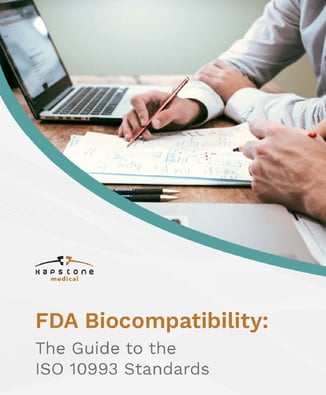The regulatory framework around bringing a medical device to market in the United States is complex. While the US FDA provides timely and comprehensive guidance on regulations and submissions, medical device manufacturers often have additional questions throughout medical device design and development projects.
FDA Q-submissions — commonly referred to as Q-subs — are a vehicle for direct contact with and feedback from the US FDA. Medical device manufacturers that avail themselves of the opportunity find Q-submissions beneficial for strategically preparing, positioning, and completing their regulatory submissions.
The Scope & Purpose of the Q-submission Program
A Q-submission is voluntary, although the Kapstone team regularly recommends them. The program is an effort by the US FDA to support industry, and therefore innovation, by allowing for dialogue between the agency and a manufacturer. If done correctly, the entire US FDA submission process can be more time and cost efficient.
Medical device manufacturers can use the Q-submission program to ask the US FDA to address processes, regulation ambiguity, or other questions. However, it should be noted that a Q-submission is one of those “you get out of it what you put into it” scenarios. Open ended questions are not recommended, because the program isn’t intended for soliciting specific answers and direction from the US FDA. Rather, Q-subs are used for presenting a plan that Agency reviewers can evaluate and provide specific feedback.
There are a few types of Q-subs:
Pre-Submissions (Pre-Subs)
Pre-Subs provide sponsors with the chance to receive and discuss feedback prior to an intended premarket submission (e.g., IDE, PMA, HDE, De Novo request, 510(k), Dual, BLA, IND). Questions specific to review topics related to the planned submission are posed to the US FDA, such as biocompatibility, bench testing, cybersecurity, etc.
Any Pre-Sub feedback may help guide device development or submission preparation, but is not considered any sort of submission or data pre-review. All discussion that occurs during a Pre-Sub is documented in meeting minutes transcribed by a designated person on the submitter’s team, and provided to the US FDA for review and approval as to accuracy.
In the case of 510(k) submissions, the voluntary PreSTAR online template can be used for Pre-Subs, but the tool limits requests to four categories and a maximum of 10 questions.
Note that Pre-Sub is not an accepted pathway for confirmation of classification. The Agency reviewer will refer you to their 513(g) classification request pathway.
Submission Issue Requests (SIRs)
In the event the US FDA issues a marketing submission hold letter, an IDE Letter, or an IND Clinical Hold letter, a medical device manufacturer can request feedback through Submission Issue Requests (SIRs).
The SIR facilitates interaction between the US FDA and the submitter by clarifying:
-
-
- Additional information needed for 510(k)s, De Novo requests, CWs, and Duals
- Major Deficiencies, Not Approvable, Approvable with Deficiencies, Approvable Pending GMP, and Approval with PAS conditions for PMAs and HDEs
- Complete response letter for Biologics License Applications (BLAs)
-
A SIR is beneficial for ensuring projects move forward timely, and that submitters are able to fully and formally address all outstanding questions and issues.
Study Risk Determinations (SRD)
Study Risk Determinations (SRDs) are used to ask the US FDA to decide whether a planned medical device clinical study is significant risk (SR), non-significant risk (NSR), or exempt from IDE regulations as defined by 21 CFR 812. For non-exempt studies, sponsors are responsible for determining initial risk and presenting it to the Institutional Review Board, with the US FDA being the final arbiter as to medical device SR and NSR.
Other Q-submission Types
Interactions described in other FDA program guidance documents can be tracked using the Q-sub Program. Mechanisms are available for:
-
-
- PMA Day 100 Meetings
- Agreement and Determination Meetings, generally for submitters of Class III devices or those needing support on clinical studies
- Submissions associated with the Breakthrough Devices Program
- Submissions associated with the Safer Technologies Program (STeP)
-
Informational Meetings & Additional Q-submission Program Uses
The Q-submission Program can also be used to request an Informational Meeting, wherein a manufacturer shares information with the US FDA without expectation of feedback.
Informational meetings are helpful in getting FDA review teams familiar with ongoing device development related to submissions anticipated to occur within 6 to 12 months, and/or new devices with significant technological differences from currently available devices. FDA review teams may ask clarifying questions, but generally treat Informational Meetings as listening sessions. They will not provide any feedback to manufacturers.
Additionally, interactions with the US FDA that do not fall under defined Q-sub types may be tracked and responded to using specific Informational Meeting Q-sub types, including:
- Request for US FDA feedback on specific questions or cross-cutting policy matters from other government agencies, non-profits, trade organizations, and professional societies
- Request for recognition of publicly accessible genetic variant databases
- Request for US FDA feedback on design elements of a clinical study that do not fall within the scope of a Pre-Sub
- Combination product agreement meetings (CPAM) as defined under section 503(g)(2)(A) of the FD&C Act
- Requests for US FDA feedback related to compliance actions
Falling Outside of the Q-submission Program Scope
The Q-submission Program is an effective mechanism for obtaining feedback from the US FDA. However, it’s not always the appropriate choice for medical device manufacturers and other medical industry professionals to get the information they need.
Interactions that fall outside of the scope of a Q-sub include:
- Requests for feedback regarding development of a Medical Device Development Tools (MDDT). Previously tracked as Informational Meeting Q-submissions, MDDT are now tracked using a universal tracking number (UTN)
- Administrative questions or submission process questions. These inquiries may be handled via email or telephone call
- Teleconferences or emails with US FDA staff by lead reviewers or Regulatory Project Managers discussing general US FDA policy, procedures, or review clarification questions
- Interactive review of issues identified while an IDE, IND, or marketing submission is under active FDA review
- Requests for appeal meetings made to CDRH or appeal meetings made to CBER
5 Benefits of Q-submissions
Medical device manufacturers realize several key advantages through the Q-sub process that help in developing robust, compliant regulatory FDA submissions, namely:
- Fewer review cycles since the US FDA can flag deficiencies early for device manufacturers to address prior to submission.
- Clarification of requirements as to what testing, data, and information is needed for timely approval.
- Risk assessment directly from the US FDA that guides mitigation strategies, and aids in demonstrating device safety and effectiveness.
- Avoiding common mistakes associated with erroneous assumptions and other submission pitfalls as identified by the US FDA review team.
- Guidance on study protocols that align with regulatory requirements and circumvent approval delays or rejections.
Timing is Everything
The timing of a Q-sub request is critical. A premature request based upon assumptions or a lack of clearly defined information about the medical device could waste time and resources, as well as necessitate a follow-up Q-sub. This can further delay regulatory submissions and ultimately slow time to market.
Successful Q-submission packages include key details, materials, testing and performance protocols, and other information the US FDA needs to understand the proposed device and clearly answer specific questions about it.
Provided the Q-sub package submitted electronically through the eCopy portal contains the necessary information for review, timelines generally run as follows:
- US FDA screens the request, assigns a tracking number, and sends an acceptance letter within 15 days
- US FDA reviewers evaluate the submission and provide feedback, usually within 60 days
Based on the feedback and guidance, medical device manufacturers are then able to adjust strategies and information to make sure submissions are best positioned for approval.
Additional Q-subs can be submitted throughout medical device and development to address questions that arise as the process evolves. However, a word of caution: While multiple Q-subs are available to manufacturers, using them can interfere with timelines.
Instead, work with a medical device consultancy experienced in leveraging Q-subs, such as Kapstone Medical. We understand the importance and impact of Q-subs, and are proficient in using the tool to gain competitive advantage.
Learn how Kapstone puts its regulatory expertise to work for you by reading FDA Biocompatibility: The Guide to ISO 10993 Standards. Click the button below to download your copy.




